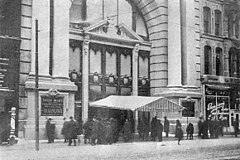 The Iroquois Theatre, shortly before the fire | |
| Date | December 30, 1903 |
|---|---|
| Time | About 3:15 p.m. |
| Location | Chicago, Illinois, U.S. |
| Coordinates | 41°53′5″N 87°37′43″W / 41.88472°N 87.62861°W |
| Cause | Ignition of muslin curtains due to broken arc light |
| Deaths | 602 |
| Non-fatal injuries | 250 |
The Iroquois Theatre fire was a catastrophic building fire in Chicago, Illinois, that broke out on December 30, 1903, during a performance attended by 1,700 people. The fire caused 602 deaths and 250 non-fatal injuries.[1] It ranks as the worst theater fire in the United States, surpassing the carnage of the Brooklyn Theatre fire of 1876, which claimed at least 278 lives.[2]
For nearly a century, the Iroquois Theatre fire was the deadliest single-building disaster in American history.[3] Only the destruction of the World Trade Center on September 11, 2001, claimed more lives in a disaster affecting an American building.[4]
Despite being billed as "absolutely fireproof", the Iroquois Theatre, which opened a month before the fire, exhibited numerous deficiencies in fire readiness that contributed to the high death toll. Some of these deficiencies were known by city officials tasked with public safety. The resulting scandal resulted in changes in building safety codes and code enforcement in the United States and throughout the world.[5]
The fire broke out at about 3:15 p.m. while the Iroquois presented a matinee performance of the musical Mr. Blue Beard starring Eddie Foy. A broken arc lamp ignited some muslin curtains, which stage managers were unable to douse; an attempt to lower the safety curtain to contain the fire was unsuccessful. Despite attempts by Foy to calm the crowd, audience members frantically rushed for the exits, only to find that fire exits were locked or hidden. The largest death toll was at the base of stairways, where hundreds of people were trampled, crushed or asphyxiated; some people jumped to their deaths from the fire escapes. The Iroquois had no fire-alarm box or telephone, which hampered initial rescue efforts. It is estimated that 575 people were killed on the day of the fire, with dozens dying afterward; the vast majority of those killed were audience members.
Two features, the safety curtain and fire dampers, were either not present or not working at the time of the fire. Other contributing factors included a lack of exit signs, emergency lighting, or fire preparedness; doors that opened inward or were latched shut; confusing exit routes; icy fire escapes; and the presence of ornamental doors. The Iroquois Memorial Hospital was built as a memorial to the fire, and Chicago held an annual memorial service. The Iroquois fire prompted widespread implementation of the panic bar, asbestos fire curtains, and doors that open outward. The theater was rebuilt and operated until 1925, when it was replaced by the Oriental Theatre.
- ^ "This Day in History: Fire Breaks Out In Chicago Theater". The History Channel. Archived from the original on November 16, 2021. Retrieved February 18, 2015.
- ^ See National Fire Protection Association, Public assembly and nightclub fires.
- ^ "Deadliest single building/complex fires and explosions in the US". National Fire Protection Association. Archived from the original on December 28, 2022. Retrieved December 29, 2022.
- ^ "World Trade Center death locations revised". CBS News. Associated Press. Retrieved October 5, 2023.
- ^ Uenuma, Francine. "The Iroquois Theater Disaster Killed Hundreds and Changed Fire Safety Forever". Smithsonian Magazine. Smithsonian Institution. Archived from the original on October 15, 2023. Retrieved October 5, 2023.
